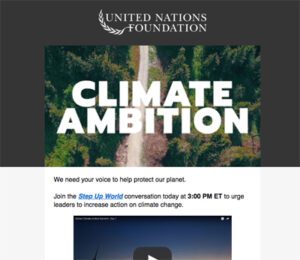
When AJ Jacob joined the United Nations Foundation last year as digital development officer, the organization was ready to make big changes to its email marketing program.
Her challenge was to revamp the email strategy in three months—before the pivotal end of year crunch for nonprofits—and reengage the inactive subscriber base.
At LitmusLive in Boston this week, Jacob shared lessons learned from her efforts to wake up sleepy subscribers. “Don’t leap before you look,” says Jacob. “Consider what you’re doing before you make drastic changes to your email program.”
Do a full audit of your email marketing program. Look at all your internal processes and procedures, to see what is and isn’t working. Consider metrics and performance, and look at your vendor relationships. Also consider a peer review, says Jacob. “Ask trusted marketers and designers to review your email design and feel. If you can’t afford a consultant, ask friends and family.”
You May Also Enjoy:
- Tips from Grammarly on Creating an Email Flagship Product
- Smart Ways to Harness the Power of Testing in B2B Email
Consider your priorities. Why are you sending emails? Do you want to encourage sign-ups or donations? Do you want to educate your audience? Know what you’re trying to accomplish and then set specific, measurable, achievable goals, she says. “Goals and priorities are not the same,” she says. “If everything is a priority, then nothing is a priority.”
Evaluate your ESP. Changing email service providers can be a major investment of time and money, but it can be worth it if it will improve your subscriber experience. Consider factors such as whether they have a dedicated IP, how user friendly their tools are, how much ability there is to customize and what the options are in the future for segmentation.
Clean your data. Scrub your lists for fake or dead email addresses and dedupe records. When moving to a new system, move over only the data that you really need, and keep an eye on turning raw engagement and behavorial data into actionable information. “Nonprofits in particular really struggle with letting go of subscribers,” she notes. “But a list scrub and recency/frequency targeting can improve deliverability.”
Be strategic in your redesign. “Design plays as central role in perceived legitimacy for a digital audience,” Jacob notes. Make all your templates and landing pages responsive and remove unnecessary clutter from your email templates, creating with a “human-first” design aesthetic in mind.
Know your audience. It is essential to know who you are writing your email copy for, she says. For the United Nations Foundation, for example, their audience was comprised of very engaged citizens, as well as subject matter experts and more casual readers who might not even remember signing up to receive messages from the UN.
Have a strong call to action. Figure out what works best for you. “Learn why it matters” may perform better than “Read more.” For the UN Foundation, direct fundraising not surprisingly aren’t the strongest CTAs, but invitations to events and surveys—both of which can be indirect fundraising tactics—get a good response. Surveys also have the benefit of serving as a strong collection tool for self-reported data. The UN’s new supporter survey gives subscribers an opportunity to self-identify themselves as prospects for volunteering, advocacy and even major gifts.
5 Pillars of Email Segmentation
Jacob shared the United Nations Foundation’s five pillar segmentation model for its email subscriber base.
- Who They Are: Private citizens, journalists and politicians
- What They Are Passionate About: A wide range of issues, including climate change, women’s issues, global health and technology
- Frequency: How often they engage with the UN’s emails—every email, sometimes, never
- Recency: When was the last time they engaged with a message? Are they a new subscriber? Have they opened a message this week—or not for a year?
- Supression: Why are they on this list? Did they have a negative interaction with the organization? Or, are they a VIP, and it would be inappropriate to send them messages with things like an ask for a low ticket donation?

 Network
Network

